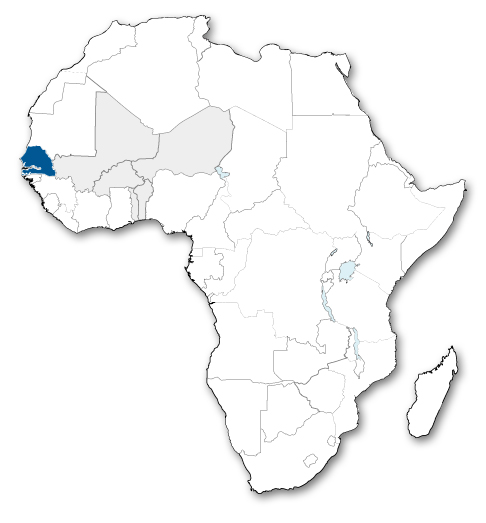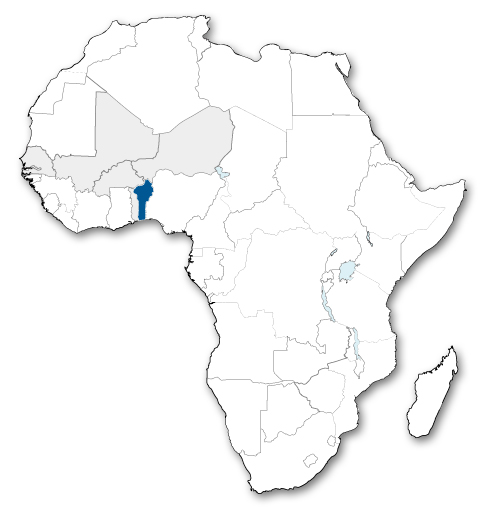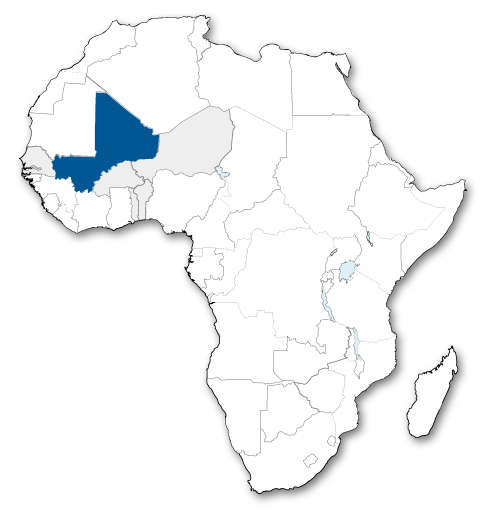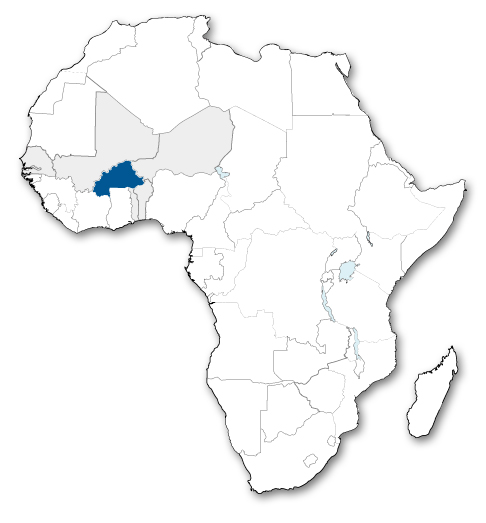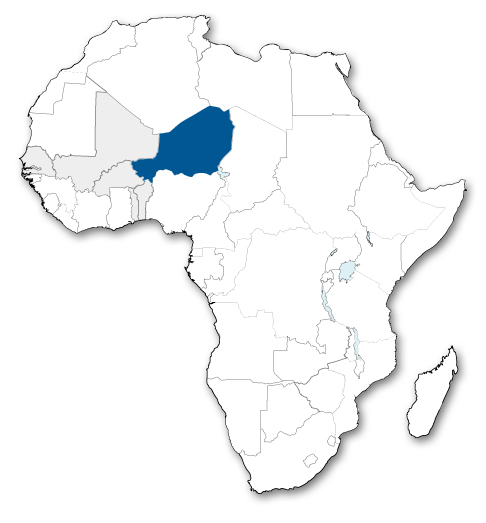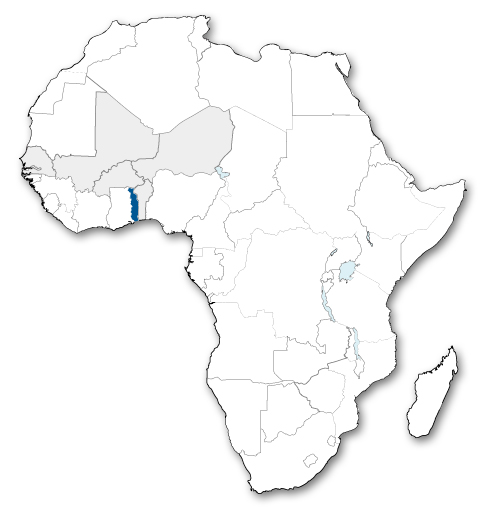
• Area: 1,241,000 km2
• Capital: Bamako
• Population: 12.7 million inh.
• Area : 115,000 km2
• Capital : Cotonou
• Population : 7 million inh.
• Area : 57,000 km2
• Capital : Lomé
• Population : 5.5 million inh.
• Area : 197,000 km2
• Capital : Dakar
• Population : 11.9 million inh.
• Area: 274,000 km2
• Capital: Ouagadougou
• Population: 15.7 million inh.
• Area: 1,267,000 km2
• Capital: Niamey
• Population: 15.2 million inh.
Countries supported
Through its joint activities with WHO / AFRO and the NGOs in the NoNoma Federation, the Winds of Hope Foundation is present in eight countries in sub-Saharan Africa:
• Regional Programmes for Fighting Noma: Niger, Burkina Faso, Mali, Benin, Togo, Senegal
• Regular supports for NGOs: Niger, Burkina Faso, Mali,
• Support for NGO-led projects: Burkina Faso, Mali, Benin, Guinea Bissau, DR of Congo
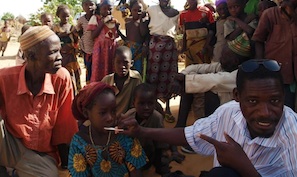
Niger
Niger, the first country to receive support from the Winds of Hope Foundation, was identified as the pilot country because of the government's strong interest in mobilizing forces against noma. The first National Program for Fighting Noma (NPFN), under the aegis of the Ministry of Health and the WHO Regional Office for Africa, was designed and implemented in 2000, thanks to Winds of Hope's first grant of money.
This program was exemplary, because it brought together all the political and health authorities, as well as local representatives of the NGOs Sentinelles (Switzerland), Hilfsaktion (Germany) and Campaner (Spain), so as to achieve maximum effectiveness in implementing the preventive and early detection measures needed for the elimination of noma. It was its success that encouraged Winds of Hope to extend the same type of campaign to other countries.
From 2000 to 2009, the Ministry of Health coordinator in charge of the NPFN was Dr. Mamane Kaka. He was replaced in 2010 by Dr. Oumarou Djibo. He answers directly to the Disease-Control Directorate, including endemic disease, under the aegis of the Directorate-General of Health.
In 2001, following their incorporation into the National Program for Fighting Noma in Niger, the NGOs Sentinelles (Switzerland), Hilfsaktion (Germany) and Campaner (Spain) received a grant from Winds of Hope to support their campaigns to fight against noma.
The highest noma rates are concentrated in three regions of the country:
• Tahoua, which has 30% of the cases identified
• Zinder with 27% and
• Maradi with 22%
Health System
The health system has three levels, constituting the healthcare pyramid:
• Health districts, which themselves have three levels: the 2,160 local dispensaries (CS), the 829 integrated health centers (CSI) and the district hospital;
• 6 regional hospitals (CHR) and two regional maternity hospitals (MR);
• 3 national hospitals (CHU) in Niamey, Zinder and Lamordé.
Health and Society Background Data
• Population: 3.3% annual growth
• 7.1 children per woman – a high fertility rate
• 80% of the population rural-based, 15% nomadic
• 20% of the population literate
• 56% of boys enrolled at primary school, and 40% of girls
• 62% of the population live below the poverty threshold
• 29% of the population do not have access to healthcare facilities
• Maternal mortality rate: 6.5 per 1,000 live births
• Rates of child mortality: 162 per 1000 live births
• 11.4% of children aged 0-5 years are in a state of malnutrition
• 80% of children aged 5 to 12 have deficiencies in their oral hygiene
Person to contact in case of detection of noma:
Sentinelles / ONG
BP27 - Zinder
zinder@sentinelles.org
+227.20.51.01.95
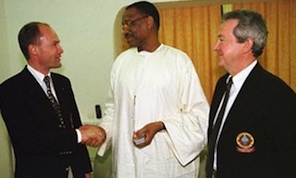
Burkina Faso
The National Program to Fight Noma (NPFN) in Burkina Faso was launched in late 2003 as part of the 5-year partnership signed in 2003 with WHO. The activities themselves became effective in mid-2004. As proof of the commitment of the authorities, the First Lady, Mrs. Chantal Compaore, agreed to chair the national Committee against Noma.
Since 2003, the Ministry of Health coordinator in charge of the NPFN has been Dr. Jocelyne Garé. She answers directly to the Department of Non-Communicable Diseases of the Directorate for disease control, under the aegis of the Directorate-General of Health.
In the absence of clarification from the Ministry of Health - pending since late 2010 - of the role played by community health workers (CHWs), and more specifically about the ban on opening children’s mouths as part of their prevention work, Winds of Hope has decided not to release any funds for the first component of strengthening and developing skills.
Health system
The health system has three levels constituting the healthcare pyramid:
• The 63 health districts, consisting of two levels: the 1,373 health and social promotion centers (CSPS) and 73 medical centers (MC), including 42 with a surgical unit (CMA);
• 9 regional hospitals (CHR);
• 3 national hospitals (CHU).
Added to this are 387 private health facilities
Health and Society Background Data
• Population: 3.1% annual growth
• 6.2 children per woman, a high fertility rate
• 13 regions, 45 provinces, 351 rural and urban communes, 350 departments and 8,228 villages
• 32% of the population literate
• 46% of the population under 15 years old
• 77% of population rural-based
• 46% of the population live below the poverty threshold (less than CHF 150 per adult per year)
• 74% of children enrolled at primary school
• Infant mortality rate: 81 per 1000 live births
• Maternal mortality rate: 3.07 births per 1,000
• Life expectancy 56 years
List of people to contact in case of detection of noma:
Sentinelles / ONG
Quartier Paspanga
01 BP 2880
Ouagadougou
ouaganoma@sentinelles.org
+226 50 30 02 67
Persis Burkina / ONG
Dr Lassara Zala
cmcpp123@gmail.com
+ 226 70 26 15 13
Hymne aux Enfants / ONG
Dr Madibélé Kam
kammadi@yahoo.fr
+ 226 50 47 27 87
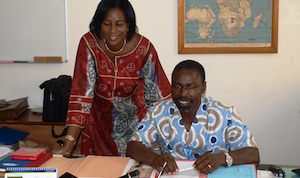
Mali
The National Program to Fight Noma (NPFN) in Mali was launched in late 2003 as part of the 5-year partnership signed in 2003 with WHO. The activities themselves became effective in mid-2004.
From 2003 to 2007, the Ministry of Health coordinator in charge of the NPFN was Dr. Gniéléba Traoré. In 2009, Dr. Bogoba Diarra was appointed but remained in office only a few months. Since 2010, the noma-coordinator post in the National Health Directorate (DNS) has sadly been vacant. Responsibility for the NPFN is shared uncomfortably between the head of non-communicable diseases, Dr. Diarra Nazoum and the director responsible for disease control. Yet the Dentistry department at the CHU in Bamako, opened several years ago, has a large pool of dental-surgeons who could fill the position within the DNS. Discussions took place in 2011 between the WHO and the Ministry of Health of Mali. It seems that steps should soon be taken to reinstate somebody to take charge of noma in the Ministry.
In 2012, the security situation deteriorated sharply in Mali, which had the effect of greatly reducing the scope and magnitude of NPFN 2012.
Health system
The health system has three levels constituting the healthcare pyramid:
• 60 health districts with two levels: the 993 Community Health Centers (CSCOM) and the Referral Health Centers(CSREF) for each local district (“cercle”), which correspond to district hospitals;
• 6 public hospitals for second-level referrals (EPH) which correspond to regional hospitals;
• 3 university public hospitals for third-level referrals (EPH-CHU).
In addition, there is one other semi-public hospital, and various private and religious healthcare facilities, as well as the health services of the INPS (national social security)
Health and Society Background Data
• 8 regions plus the District of Bamako, 49 districts, 684 urban and 19 rural communities
• 46% of the population under 15 years old
• 73% of population rural-based
• 50% of people do not have access to drinking water
• 53 year life expectancy, 51 for men, 55 for women
• 6.6 children per woman, a high fertility rate
• 25% of women have the capacity to breastfeed their children
• Maternal mortality rate: 4.64 per 1,000 live births
• Neonatal mortality rate: 55 per 1,000 births
• Infant mortality rate: 96 per 1000 live births
• Rates of child mortality: 191 per 1000 live births
• 78% of children enrolled at primary school (97% of boys and 68% of girls)
• 21% of the population literate (12% of women)
List of people to contact in case of detection of noma:
Coordonnateur du Programme national de lutte contre le noma / Ministère de la santé
Dr Baba Diallo
babasidikidiallo@yahoo.fr
+ 223 74 56 54 28
Au Fil de la Vie / ONG
Boubeye Maiga
Immeuble Enda Tiers-monde
Rue 424, Porte 200, Ouolofobougou
Bamako - République du Mali
+223 66 72 88 76/+223 76 05 86 24
Dr Moussa Baba Daou
Chirurgie Plastique, Reconstructive et Esthétique
daoumoussa07@gmail.com
+223 60 96 39 84
Benin
The National Program to Fight Noma (NPFN) in Benin was launched in late 2003 as part of the 5-year partnership signed in 2003 with WHO. The activities themselves became effective in mid-2004. A multidisciplinary and multi-sectoral national committee to fight Noma with 19 members was also set up.
Since 2003, the Ministry of Health coordinator in charge of the NPFN has been Dr Armande Gandjeto. She answers directly to the Department of Non-Communicable Diseases of the Directorate for disease control, under the aegis of the Directorate-General of Health.
Health system
The health system has three levels constituting the healthcare pyramid:
• the 359 district health centers (CSA) and 80 community health centers(SCC);
• 34 zone hospitals (HZ) and 5 county hospitals (CHD);
• Cotonou National University Hospital (CNHU).
In addition, there are various religious and private health facilities.
Health and Society Background Data
• 40% of the population live below the poverty threshold
• 56% of the population have no running water
Togo
The National Program to Fight Noma (NPFN) in Togo was launched in late 2006 as part of the extension that same year of the 5-year partnership with WHO originally signed in 2003. The activities themselves became effective in mid-2007.
Since 2006, the Ministry of Health coordinator in charge of the NPFN has been Dr Pierre Jimongou. He answers directly to the Community Health Department of the Directorate for primary health care, under the aegis of the Directorate-General of Health.
Health system
The health system has three levels constituting the healthcare pyramid:
• The health district, with 35 district hospitals (HD) and 6,000 peripheral treatment centers ;
• 6 regional hospitals (CHR) ;
• 3 university hospitals (CHU) containing national referral centers.
Health and Society Background Data
• 51% of the population below 15 years of age
• 71% of the population live below the poverty threshold
• 24% of the population live in a state of chronic malnutrition
• 80% of children aged between 5 and 12 have deficient oral hygiene
Person to contact in case of detection of noma:
Coordonnateur du Programme national de lutte contre le noma / Ministère de la santé
Dr Pierre Jimongou Sambiani
jimongou@yahoo.fr
+ 228 90 04 74 28
Senegal
The National Program to Fight Noma (NPFN) in Senegal was launched in late 2006 as part of the extension that same year of the 5-year partnership with WHO originally signed in 2003. The activities themselves became effective in mid-2007.
Since 2006, the Ministry of Health coordinator in charge of the NPFN has been Dr Pr Daouda Faye. He answers directly to the Oral Hygiene Division under the aegis of the Directorate-General of Health.
Health system
The health system has three levels constituting the healthcare pyramid :
• 65 health districts encompassing 78 health centers, 1,195 health outposts, 1,603 local dispensaries and 476 rural maternity units;
• 14 medical regions, each with a hospital or public regional health establishment (EPS);
• 7 national hospitals or public health establishments for nation-wide referrals.
Health and Society Background Data
• Population: 2.7% annual growth
• 5.3 children per woman, a high fertility rate
• 14 regions, 45 departments divided into 114 communes, 123 districts and 370 rural communities
• 38% literacy rate for adults (15 and over), 28% in women and 49% men
• 58% of children enrolled at primary school
• 57% of the population live below the poverty threshold
• 55% of the population under 20 years old
• 58% of population rural-based
• Maternal mortality rate: 4.34 per 1,000 live births
• Neonatal mortality rate: 53 per 1,000 births
• Infant mortality rate: 61 per 1000 live births
• Rates of child mortality: 121 per 1000 live births
Guinea-Bissau
In 2009, following the impact made by Noma Day, a campaign of information, training and education for prevention was carried out by the Hilfsaktion Noma association, right across the country. Training seminars were organized in all health regions for 492 doctors, nurses, birth attendants, parents, educators, traditional community leaders, opinion formers, healers, communicators, journalists, NGOs, etc. In addition, awareness-raising sessions at public gatherings reached 1,881 school children, 1,186 community health workers and 3,500 other people.
Health and Society Background Data
• Population: 2.0% annual growth
• 41% of the population under 15 years old
• 46 years life expectancy for men, 49 for women
• 4.6 children per woman
• Infant mortality rate: 100 per 1000 live births
D.R. of Congo
Health and Society Background Data
• Population : 3.1% annual growth
• 47% of the population aged under 15
• Life expectancy 51 years
• Infant mortality rate : 88 per 1000 live births
Person to contact in case of detection of noma:
Non au Noma en RDC / ONG
Sady Kipasa
sadykipasa@yahoo.fr
+ 243 89 39 353






